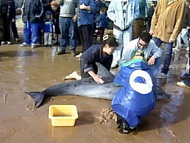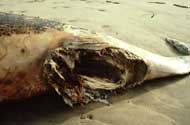|  Every
year a lot of cetaceans are found on our
beaches. The most part of these animals
are died in the sea which carcasses are
driven at shore. They could be died for
natural or artificial causes. Occasionally
alive animals too , arrive on the beach
to times alone, to times in group , what
is the matter that provokes the run aground,
in any case, is a motive of great perplexity
for biologist, but often it’s possible to
distinguish natural causes from artificial
causes. For natural causes it is understood
the death due to old age, bacterial or parasitic
infections (young specimen of sperm
whale (Physeter macrocephalus) ; Grampo
(Grampus griseus) (probably died for bacterial
infection) , Every
year a lot of cetaceans are found on our
beaches. The most part of these animals
are died in the sea which carcasses are
driven at shore. They could be died for
natural or artificial causes. Occasionally
alive animals too , arrive on the beach
to times alone, to times in group , what
is the matter that provokes the run aground,
in any case, is a motive of great perplexity
for biologist, but often it’s possible to
distinguish natural causes from artificial
causes. For natural causes it is understood
the death due to old age, bacterial or parasitic
infections (young specimen of sperm
whale (Physeter macrocephalus) ; Grampo
(Grampus griseus) (probably died for bacterial
infection) ,
 and
to attacks from the predators (on the photo
a great bite of shark on a specimen of tursiope
(Tursiops truncatus)). The artificial causes
are almost always due to the interaction
with the man. The deaths can be caused:
from the fishing tools (in the photo to
the right a zifio (Ziphius cavirostris)
entangled in net from fishing) from the
pollution of the waters or from the impact
with big boats (photo 5-Stenella (Stenella
ceruleoalba) injured provoked from the impact
with the propeller of an engine’s boat)) and
to attacks from the predators (on the photo
a great bite of shark on a specimen of tursiope
(Tursiops truncatus)). The artificial causes
are almost always due to the interaction
with the man. The deaths can be caused:
from the fishing tools (in the photo to
the right a zifio (Ziphius cavirostris)
entangled in net from fishing) from the
pollution of the waters or from the impact
with big boats (photo 5-Stenella (Stenella
ceruleoalba) injured provoked from the impact
with the propeller of an engine’s boat))
Often the animal found on the shore , is
dead in sea and the currents transported
to land the carcass.
In this case, the autopsy on the body of
the cetacean supplies a surprising quantity
of useful information to the study of the
biology of these animals. In a lot of cases
the animal run aground is still alive and,
according to the conditions in which it
is found, tries to save it and to replace
it in sea cogia
(Cogia
of Owen). A speech to part, goes done ,
on the mysterious run aground in alive mass
of animals that often involves several tens
of individuals and on that were advanced
a lot of theories. An of the most spread
it is that according to which the animals
would lose the orientation because of the
variations of the magnetic field earthling.
Lately they have done new road hypothesis
that stretch out to attribute the cause
of the spiaggiamenti at the acoustic pollution
(drilling on the marine fund, modern systems
of television-communication, ecc. ) Steni
(Steno brendanensis).
Run aground in mass remain however a phenomenon
that it is checked from immemorial times
and that all now represents one of the greater
unresolved questions on the animal’s kingdom.
The Necton’s members , in collaboration
with the study of the cetaceans of the strait
(S.C.S) and the WWF, and the Sicilian Fund
for the nature, and with the support of
the organs of state, (Capitaneria di porto;
polizia ; carabinieri; guardia di finanza)
take care of themselves to recover some
cetaceans in difficulty, the period in which
the frequency of the run aground is greater,
goes from the spring to the autumn, that
likely it happens because in such periods
it is had an increase in the human presence,
and is shown from the fact that the animals
in difficulty, present in the greater part
of the cases deep injured caused from the
impact with the propellers.
|